
In the early Chinese civilization, most of the study utensils were used to record life. When the picture book came into being, pictures and books also became the carrier and symbol of civilization. In addition to books and cloth and silk, early characters were also carved together, and the appearance of knives and pens promoted the development of pictures to characters. Legend has it that the brush was invented by Meng Tian in the Warring States Period, but judging from the traces of writing, the brush was proficiently used to write characters on oracle bones during the Yin and Shang Dynasties. Ink and cinnabar, as representatives of early pigments, were all taken from nature. There are ink books in oracle bone inscriptions. Although less unearthed, it also proves the application of ink at that time. The Mozuizi Han Tomb in Wuwei, Gansu Province used to be accompanied by a writing brush and ink balls. From "engraving on bone armor" to "writing on bamboo and silk", the application of brush and ink and the development of writing have undergone a qualitative leap in the Shang and Zhou dynasties.
The appearance of paper predates the legendary papermaking of Cai Lun in the Eastern Han Dynasty. The Baqiao paper unearthed in Xi'an in 1957 is a relic of paper in the period of Emperor Wu of the Western Han Dynasty, and it is the earliest plant fiber raw material paper in my country. The paper is rough and the surface is not smooth enough. Although it is not easy to write characters, it has advanced the "Caihou paper" for a century.
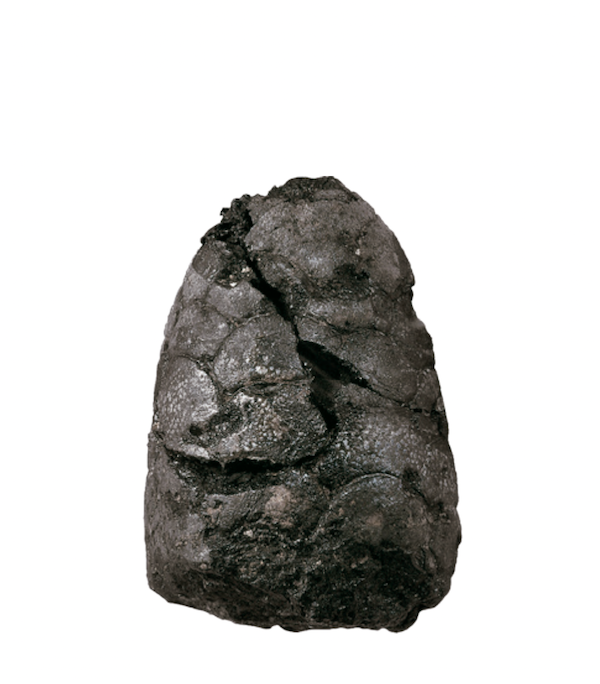
(Han) Mowan Unearthed from Mozuizi Han Tomb in Wuwei, Gansu Province, Gansu Provincial Museum
Inkstone is based on the development of ink. Only by finely grinding the synthetic ink and removing impurities, can the ink color and ink nature of the written characters be expressed. According to the research of "Xijing Miscellaneous Notes", inkstones appeared in the Han Dynasty. After the Sui and Tang dynasties, with the improvement of inkstone-making technology and the enhancement of literati's needs, inkstones are not only tools for grinding ink balls, but also become a collection of literati and scholars. thing. The Wei, Jin, Southern and Northern Dynasties were a period of transformation in which Chinese culture was influenced by Western styles. The unrestrained talk of the literati in the Southern Dynasty collided with the borderland customs of the northern nomads, which made the cultural types of this period diverse and prosperous. The life drawings of the owner of the tomb unearthed in Tomb No. 13 in Astana, Turpan, Xinjiang are the earliest existing paper paintings of the Sixteen Kingdoms period in my country. The picture unfolds horizontally, and draws a map of travel, a map of the tomb owner's rest, and a map of the kitchen. The colors in the painting are bright and bright, and the brush strokes have been divided into center and flank. It can be seen that the brush head at this time should have a longer stroke.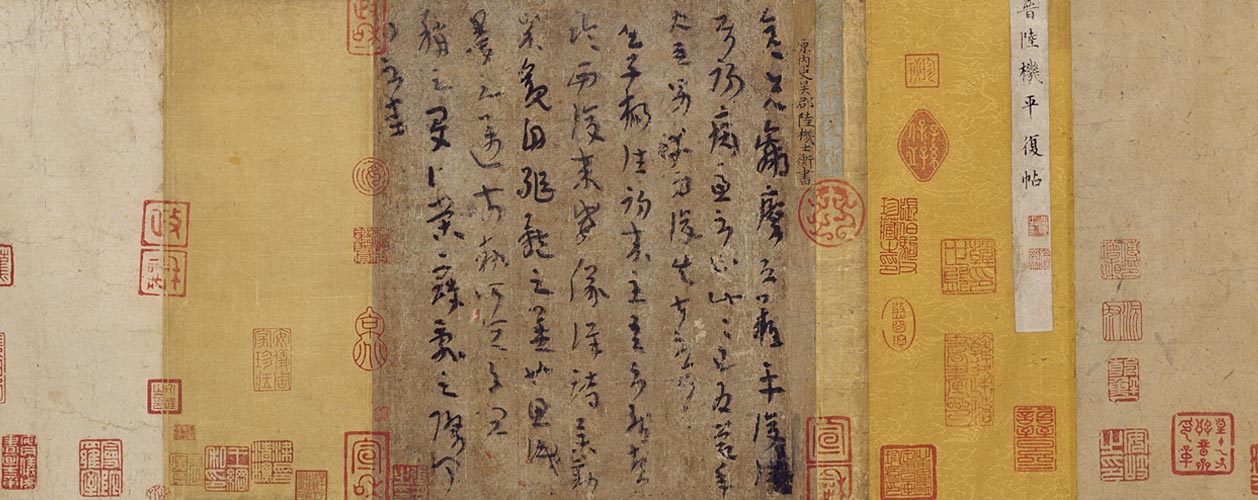
(Eastern Jin) Lu Jiping Repost (Part) Ink and pen on paper 23.7 cm long and 20.6 cm wide Collection of the Palace Museum
Compared with the scarcity of painting materials on paper, the masterpieces and masters of calligraphy in the Jin and Tang Dynasties are the most splendid chapters in the history of Chinese calligraphy. Paper was used for writing instead of silk, which generally originated in the Wei and Jin Dynasties. Jin Luji's "Pingfu Tie" is the earliest surviving authentic calligraphy of famous people in my country, and is known as the "Ink Emperor". In "Pingfu Post", there are nine lines of handwriting for Lu Ji to greet friends. The whole page is made of hemp paper. Although some of the handwriting has been lost due to damage to the paper surface, it shows the difficult nature of the Jin and Tang Dynasties paper. Among them, the ink calligraphy is between Zhangcao and Jincao. The font still has the meaning of official script, but it is not as clear as the official script. It can be seen that it is all written with a hard core pen when flipping left and right. A representative book in the evolution of grass.
(Jin) Wang Xun Bo Yuan Post (part) Ink and pen on paper, 25.1 cm long, 17.2 cm wide, Collection of the Palace Museum
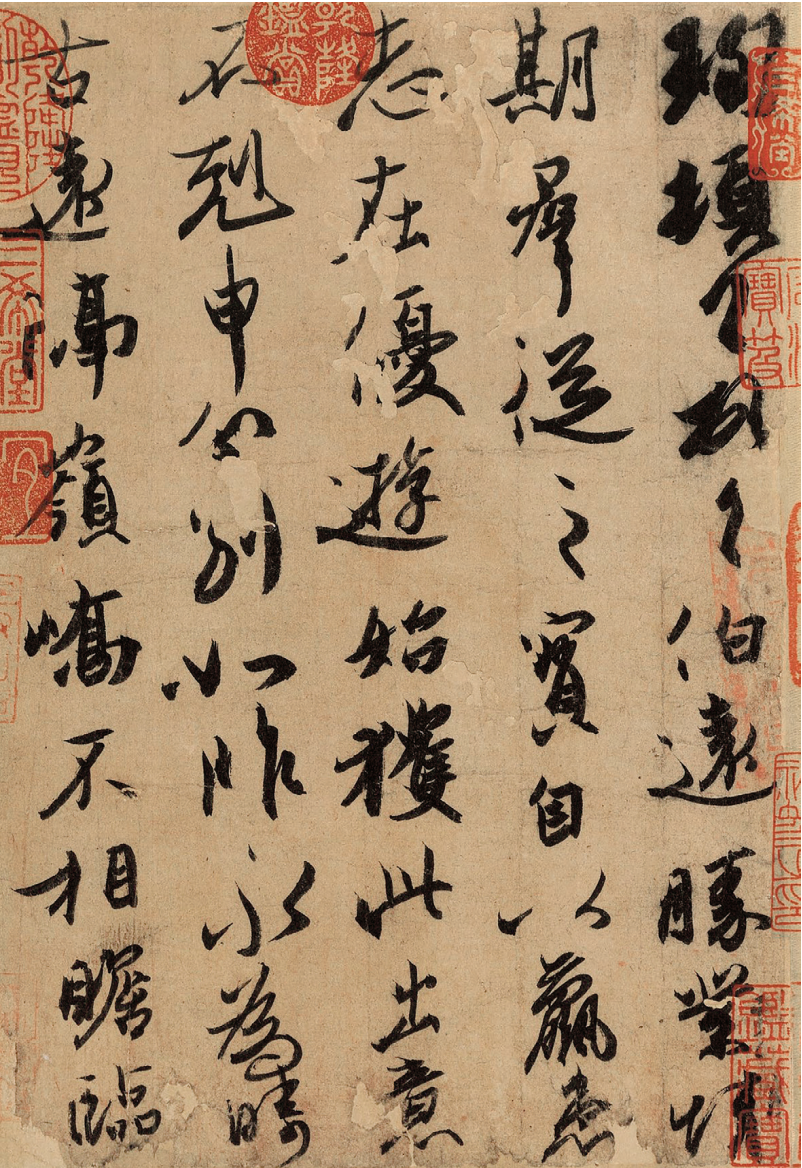
(Jin) Wang Xun Bo Yuan Post (part) Ink and pen on paper, 25.1 cm long, 17.2 cm wide, Collection of the Palace Museum
Wang Xun's "Boyuan Tie" and the previous article "Pingfu Tie" are the only two surviving calligraphy of Jin Dynasty famous people. There is no authentic work of Wang Xizhi, the "sage of calligraphy". The Wang family has been good at writing from generation to generation. Only Wang Xun, the nephew of the clan, has this short note. Emperor Gaozong Qianlong of the Qing Dynasty also cherished this post, which was framed with framing paper and painted with a royal pen to show his love. The flanking paper is a famous paper in the Wei and Jin Dynasties. Jin Wangjia's "Supplementary Notes: Current Events in Jin": "There are thousands of flanking papers, which are presented by Nanyue. , its rationale is vertical, horizontal and oblique, because it is famous." It can be seen that the famous paper of Wei and Jin Dynasties did a lot of assistance to the emergence of famous calligraphy works at that time.During the Jin and Tang dynasties, with the development of furniture from low-slung seating to Hu beds and stools, the original writing style was also constantly updated in line with the changes in seating. The Eastern Jin Dynasty's Proverbs of Women's History, now in the British Museum, is the most faithful of Gu Kaizhi's handed down paintings. Although this work is recognized as a copy of the Tang Dynasty, it still faithfully records various images of famous objects in the Eastern Jin Dynasty. "The Story of Women's History" is a famous article written by Zhang Hua from Jin Dynasty based on the deeds of virtuous concubines in past dynasties, satirizing the dictatorship of Empress Jia during Emperor Hui's time, and using this to educate court ladies. The curly-tailed female history is holding a hand-scroll with both hands, which shows the habit of writing at this time when the brush is stiff and suitable for holding the scroll.
The volume of Yang Zihua's "School Book of the Northern Qi Dynasty" currently in the collection of the Museum of Fine Arts, Boston, USA, presents us with a northern painting style different from that of Gu Kaizhi. Although this work is a copy of the Song Dynasty, it still maintains the original appearance of the painting. Northern Qi painter Yang Zihua was a well-known figure and painter of carriages and horses at that time. His paintings of horses were vivid, and he once caused viewers to have the illusion of hearing the neighing of horses at night. He was called "painting saint". During the reign of Emperor Gao Zhan of the Northern Qi Dynasty (561-565 A.D.), he served as a general of Zhige and a regular attendant of Sanqi. The figures he painted are plump and round, incorporating Hu Feng's sturdy body, which is different from Gu Kaizhi's "beautiful smoothness and beauty". His style of painting influenced the Tang Dynasty and has a historical position of linking the past and the future. This painting depicts the scene in the seventh year of Tianbao in the Northern Qi Dynasty (AD 556), when Emperor Wenxuan Gao Yang ordered Fan Xun and other eleven people to be responsible for publishing the history of the Five Classics collected by the state. In the picture, a clear Biyong inkstone can be seen above the Hu bed. "The System of Rites and Kings" records: "The university is in the suburbs, the emperor is called Biyong, and the princes are called Lei Palace." Biyong originated from the early Taixue architecture and was the place where the emperor gave lectures. Cai Yong's "Mingtang Dan Ling Lun" in the Eastern Han Dynasty stated: "It is surrounded by water on all sides, and the garden is like a birch, so it was named Biyong in later generations." Among the inkstones in the Wei, Jin, Southern and Northern Dynasties, the disc shape with feet was the most popular. This inkstone pool surrounds the inkstone hall. , such as Biyong ring water, hence the name "Biyong Inkstone". In the early days, three-legged or four-legged inkstones were more popular. In the Southern and Northern Dynasties, they evolved into pearl-footed inkstones and Biyong inkstones ranging from five-legged to full. In the Sui and Tang Dynasties, the round and multi-legged Biyong inkstones were developed.
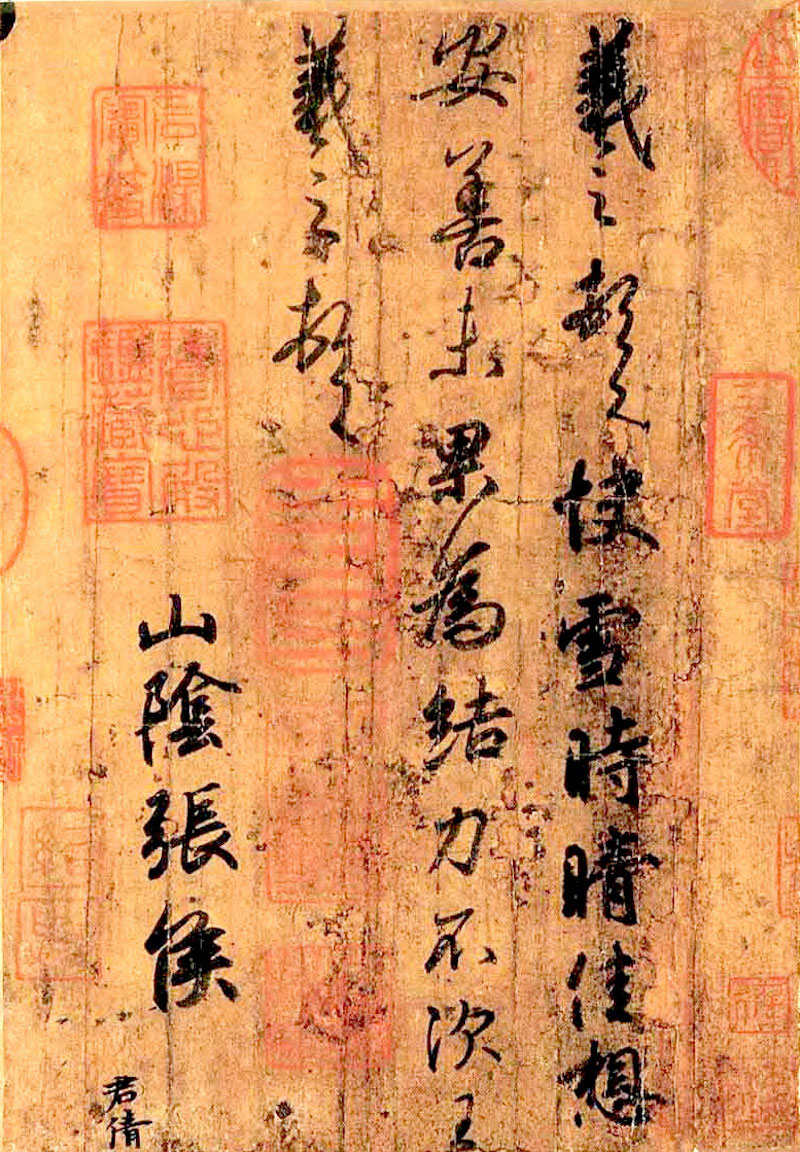
Eastern Jin Dynasty Wang Xizhi's "Fast Snow and Clear Time"
Among the "Three Hopes", in addition to "Boyuan Post", Wang Xizhi's "Quick Snow When Clear Post" is also a masterpiece. This post is a short note written by Wang Xizhi to "Zhanghou of Shanyin" to greet the Queen of the Snow. Although it is a copy of the Tang Dynasty, it faithfully retains the appearance of Wang Xizhi's works due to the use of "Yingtuo" techniques. "Yingtuo" was originally made by double-hooks of hard yellow paper in the Tang Dynasty. The hard-yellow paper was dyed and decorated with white paper to repel insects, and then dipped in wax and beaten. The texture was translucent and smooth; The details of the handwriting are carefully copied one by one to form handwriting consistent with the original. Song Dynasty Zhao Xihu's "Dongtian Qinglu" recorded: "The Tang people used hard yellow paper to write scriptures, dyed it with Huangbo, and took it. All the original works of the two kings or hard yellow paper in this world are imitations of Tang people, not genuine." In addition to the many copies handed down by Wang Xizhi, the "Long Live Tongtian Post" (one of Wang's books) is also represented by the Liaoning Provincial Museum. In this edition, in addition to filling in the rubbing outline of the original work, it also used Wusi to remove the original defect and insect erosion, which has become a first-hand material for studying the appearance of one of Wang's signatures.![(Tang) Legend of Yushou Luoshu Unearthed from the Dunhuang Sutra Cave, Gansu [English] Collection of the British Museum](https://apollopic.nodefu.net/ppoppem34wv8odjv44h1mw0vfqaz6ndf.jpg)
(Tang) Legend of Yu Shouluo Book Unearthed from the Book Collection Cave in Dunhuang, Gansu [English] Collection of the British Museum
In addition to the calligraphy of the Tang Dynasty, there are also study utensils in the paintings of the Tang Dynasty. The Legend of Yu Shouluoshu was unearthed in Dunhuang’s Sutra Cave. It is said that before the invention of writing, Fuxi’s family ruled the world with Taoism. This painting is a remnant, and there is another Yu Shouluo Shu paragraph. In the painting, Fuxi is wearing a crown suit, holding a pen and scroll, facing the tall dragon-shaped horseshoe strange beast. posture.In addition to standing writing, the Tang Dynasty also appeared in the image of writing on a low table.
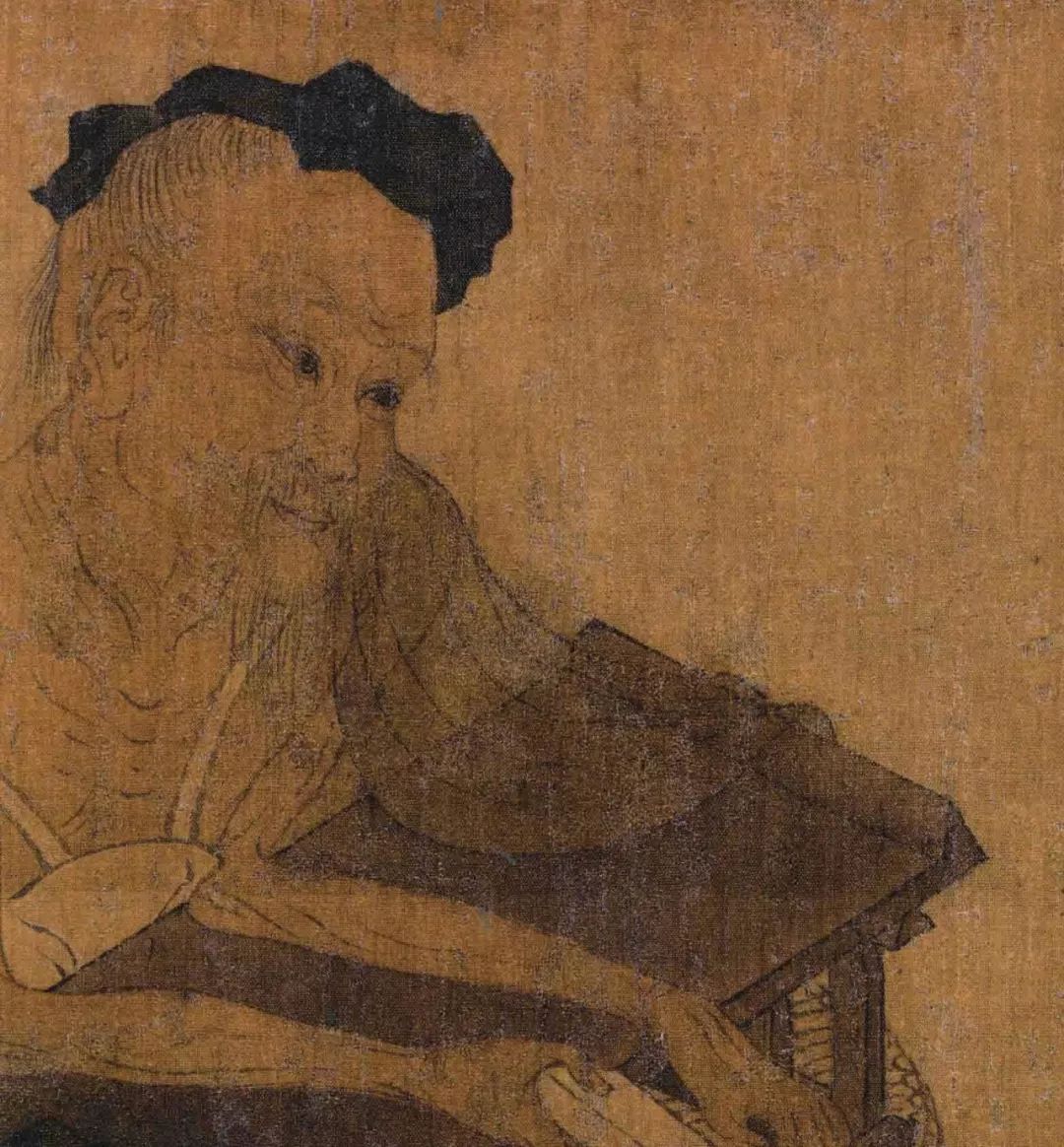
(biography) Tang Wang Weifusheng's teaching of scriptures (partial) Collection of the Osaka Municipal Museum of Art
Tang Wangwei's "Fusheng Teaching Sutras" in the Osaka Municipal Museum of Art is the least controversial Wang Wei painting in existence. The picture depicts the story of Dr. Fusheng hiding the "Shangshu" in the wall when the first emperor of Qin burned books and pitting scholars. In the early Han Dynasty, when Fusheng was over ninety years old, Emperor Wen sent Chao Cuo to study the twenty-eight chapters of "Shangshu". In the painting, Fusheng, despite his age and frailty, is still at his desk tirelessly. In front of the eight-curved foot table, you can see the accompanying inkstone and brush that have been used up and put aside, there are hand scrolls and small pot-shaped inkstone drops in front of the futon under the seat, and the hand scrolls that have been packaged in the scriptures are placed on the other side. In the painting, the shape of the inkstone is like a natural one, only the inkstone pool in the center is slightly concave, the ink color is dark, and the lower side is supported by a wooden frame, which shows that this inkstone has not been carved too much, and it is all natural beauty. This volume was once hidden in the Xuanhe Neifu of the Northern Song Dynasty, which shows that what is seen in the painting should be from the pre-Song Dynasty.In the late Tang Dynasty, with the gradual increase of the seat and several tables, the habits and forms of writing became more and more modern. The "Ten Kings of Ksitigarbha" in the British Museum is based on the "Ten Kings of Ksitigarbha" of the Tang Dynasty. In the painting, Ksitigarbha Bodhisattva wears a monk's hat, holds a meditation staff and a jewel in both hands, and sits half-legged on a stone platform. The good and evil boy and the king of the Ten Halls, who are in charge of the records of good and evil, are left and right. In the foreground are the judge Cui, the monk Daoming, the lion, and the pen holder. In the painting, the King of Hell in the Ten Halls is facing each other, and the table case has been changed to a high-footed square table, and is decorated with drapery case skirts. In addition to the scroll of life and death on the table, there is also a Ki-shaped inkstone placed on the side of the case. Ji-shaped inkstone, also known as "Jidou inkstone", is shaped like a dustpan, and is named "Wind-shaped Inkstone" because the tail of the inkstone resembles the word "wind". It was first seen in the Southern and Northern Dynasties and prevailed in the Tang Dynasty.
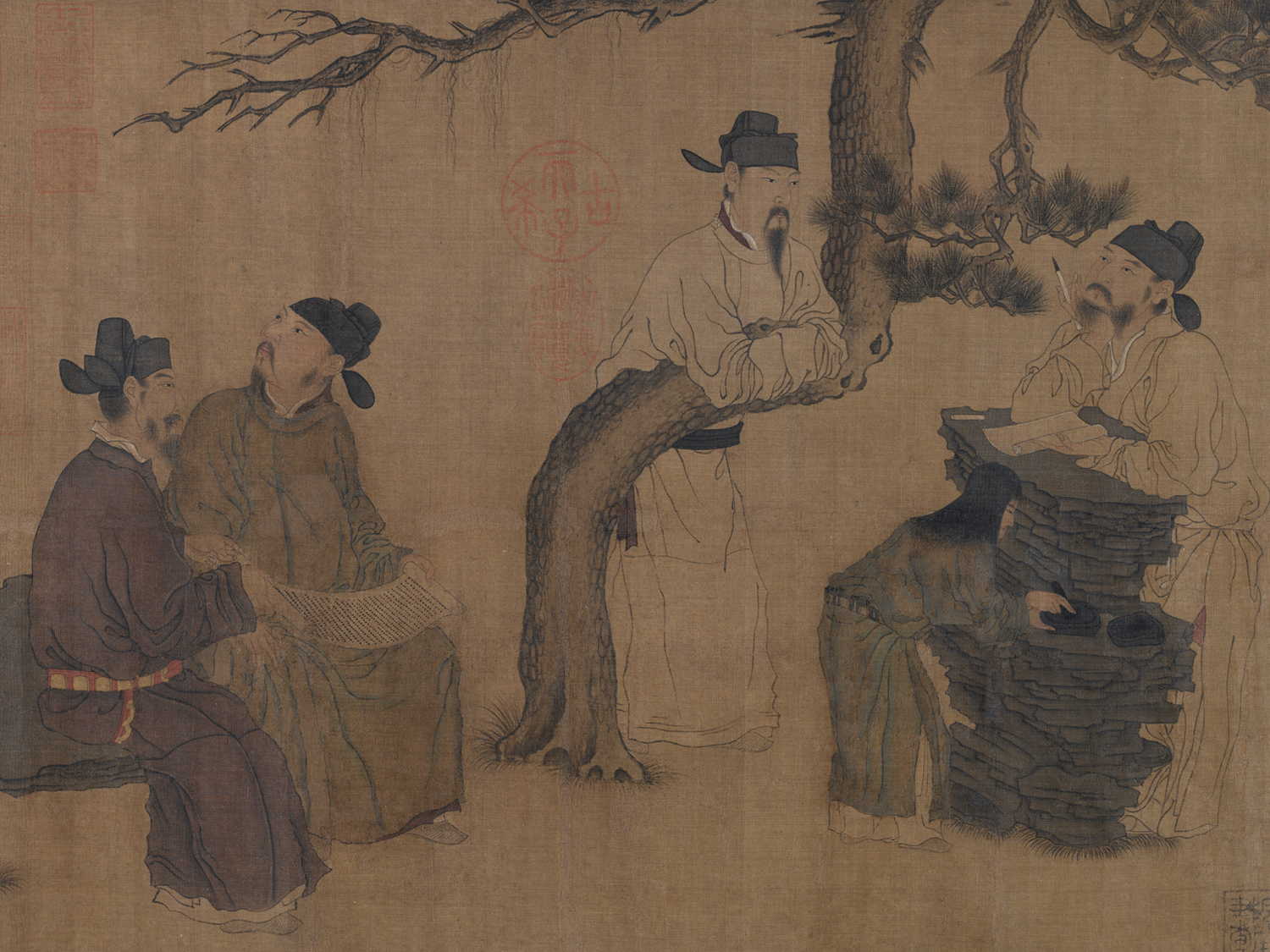
Five Dynasties Zhou Wenju's "Characters in Liulitang" volume (detail) Ink and color on silk
The Five Dynasties is an era that connects the past and the future. The split of the regime and the contention of a hundred schools of thought gave birth to a wealth of art schools, which had a particularly profound impact on the art of the Northern Song Dynasty. The Southern Tang Dynasty was the most elegant, and the emperor was not only the patron of art, but also the pursuer of art. Zhou Wenju was one of the more famous figure painters in the Southern Tang Dynasty. During the reign of the late master Li Yu (961-975 AD), he served as the imperial edict. The characters and Buddhist paintings are all exquisite. "Wenyuan Picture Scroll" is one of Zhou Wenju's handed down paintings. This scroll was originally the second half of the content of "Liu Li Tang Figures". The whole volume should depict the scene of the poetry meeting in front of the Tang Dynasty poet Wang Changling's poet friend Liu Li Tang. An overview of the Chinese painting room, Matsushita is lying on the stone platform, holding a pen and holding his jaw thoughtfully; in front of him, a servant is holding an ink ingot, carefully grinding ink in the inkstone hall. The two people at the end of the volume were reading the volume, and the baskets behind them seemed to be stationery boxes, which was quite eye-catching.For the use of paper and ink in calligraphy, the most famous ones are Li Tingmo and Chengxintang paper in the Southern Tang Dynasty. The ink made by Li Chao and Li Ting of the Southern Tang Dynasty was "rich and greasy, glossy like lacquer", and it was mostly made during the Baoda period (943-957 AD). After the Northern Song Dynasty destroyed the Southern Tang Dynasty, Ting Mo was imported into the internal library and became a collection of the court. During the reign of Emperor Huizong of Xuanhe (1119-1125 AD), it was even more "a thousand pieces of gold are easy to obtain, but Li's ink is impossible to obtain". The only surviving "Hanlin Fengyue Ink" in the National Palace Museum in Taipei is the only "Hanlin Fengyue Ink" in existence. The rectangle is slightly thinner, full of broken patterns, and the ink surface is as dark as lacquer. Rare treasure.
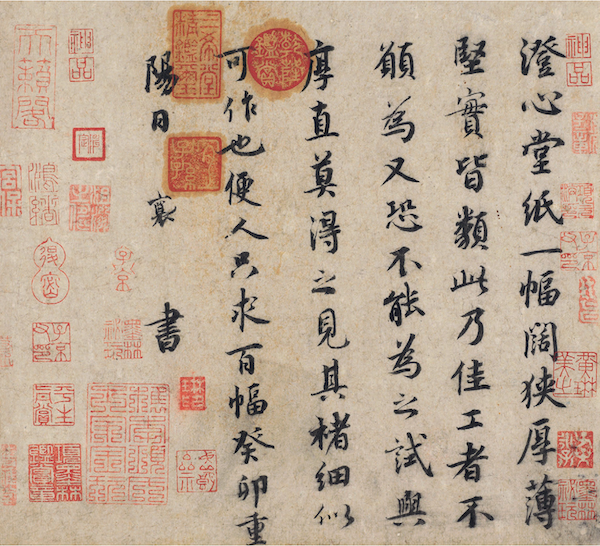
(Northern Song Dynasty) Cai Xiang, Chengxintang Post, ink pen on paper, vertical 24.7 cm, horizontal 27.1 cm, collected by the National Palace Museum, Taipei
In the eighth year of Jiayou of Renzong in the Northern Song Dynasty (AD 1063), Cai Xiang, one of the four Song families, wrote a short note to a friend and entrusted the search for the famous paper of the Southern Tang Dynasty—Chengxintang Paper. Chengxintang paper is the imperial paper made by Li Yu, the later master of the Southern Tang Dynasty, and ordered by the imperial supervisor. It is named after it is hidden in Chengxintang. Ouyang Xiu, Mei Yaochen, Cai Xiang and others all wrote poems and praises. Cai Xiang's "Chengxintang Post" paper is meticulous and clean, and it is likely that Cai Xiang used it as a sample for the trustee to search for the Chengxintang paper. At this time, Cai Xiang was fifty-two years old. He used his pen solemnly, his body was upright, and his pen and ink were graceful.The Southern Tang Academy of Painting, nourished by excellent paper and famous ink, can be described as producing talents in large numbers. Wang Qihan was the later master Li Yu when he was waiting for the imperial edict at the Hanlin Painting Academy. He worked in figures, Buddhism and Taoism. In addition to the title of Zhao Jishou's thin gold book on the front of the volume, there are also inscriptions by Su Shi, Su Zhe, Wang Xu, and Shi Gongyi in the Jin Dynasty. Beneath the huge landscape screen, the scribes must be undressed, free to pick their ears, and face the desk. The writing and ink of the study room are placed horizontally on the desk, and the volumes are piled up. The brush and ink on the side of the inkstone pond are still of strong color, which should be the time to take a rest during the inspection of the school. The Hu bed behind him is full of volumes to be examined, and there are even large scrolls that are rarely seen. It can be seen that the scrolls and paintings are already mounted on a considerable scale at this time.
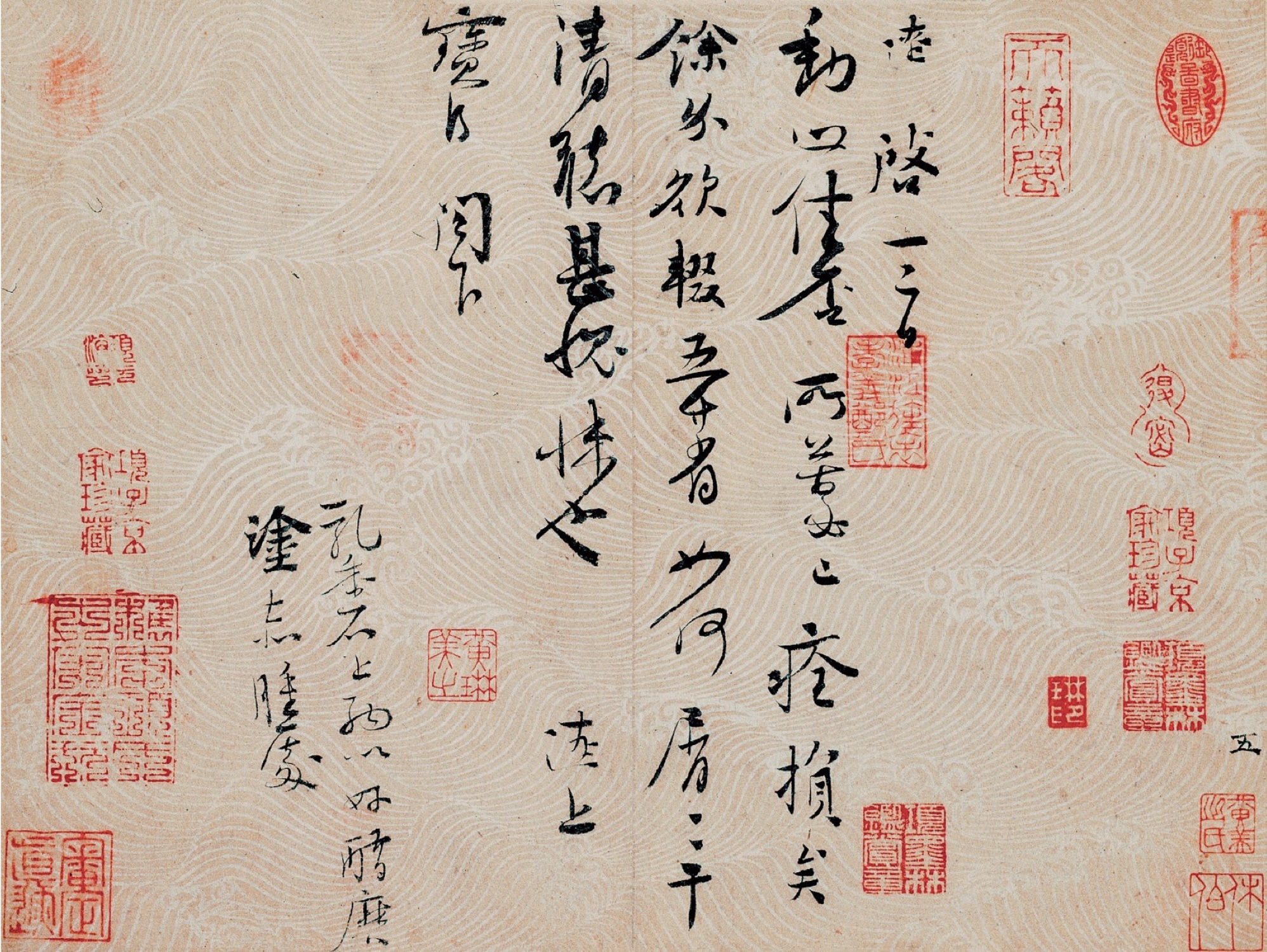
(Northern Song Dynasty) Shen Liao's running script, 27.1 cm vertical and 36.6 cm horizontal, ink pen on paper, in the collection of Shanghai Museum
During the Song Dynasty, with the development of literature and art in the inner court, the literati class scattered in various places gradually entered the social circle of the nobility and the Zhu family. Elegant collections are all over the place, and the literati life of poetry will be gradually accepted by the upper classes of the Song Dynasty, which has become a temporary trend. Shen Liao's "Running Script Movement and Stop Post" in the Northern Song Dynasty, now in the Shanghai Museum, was originally written by Shen Liao and his friends. Shen Liao is good at poetry, especially calligraphy. The writing in this post is high-spirited, and the words between the lines are graceful and elegant, and it is extremely powerful. The post is made of water-patterned flower paper, the paper surface is white and flawless, and the handwriting seems to be floating in running water, which is more elegant. Su Shi's "Book of Pu Yong Paintings" said: "In ancient and modern paintings, water is mostly flat and far and fine wrinkles, and the good ones can only make waves rise and fall. When people touch it with their hands, it is said that there are wavy and long, which is considered the most wonderful! However, its character is very clumsy with the printing plate water paper." The so-called "printing plate water paper" should be the water-patterned flower paper used by Shen Liao in this post. Song Qian Kanggong's "Zhi Ba Jian Tan" once contained "Juan paper", which was originally a precious white paper for Wu Yue (AD 907-978) to replace Zhuan Fu. The so-called "Yanbojian" in the study is a special type of calligraphy and painting paper similar to the water-patterned Huajian.Good paper is rare, especially old paper from Jin and Tang Dynasties and small-format paper. Song Huang Tingjian's "Trial Teaching Post" once said: "I want to record dozens of wonderful songs and compose music for Suoer, but I haven't done it yet. The paper sent is too high, but it can write large characters. If you want small running script, you must have short paper. It can be seen that the writing paper has been divided into different sizes at this time, and it has become a common feature of letter and scroll paper.
In the Song Dynasty, with the growth of literati's interest in appreciating stones and playing with ancient times, inkstone learning also developed. The inkstone used for researching ink in ancient times has also become an elegant object in the study where literati's inscriptions are engraved. "Inkstone Spectrum" contains: "The three items of Chengxintang paper, Li Tingmo, and Longwei inkstone used are the crowns in the world." Legend has it that Su Shi loved the dragon tail inkstone very much, and he wrote poems and praises many times. Huang Tingjian also has a poem "Inkstone Journey": "The sun is shining brightly and the Venus is flying, and the blue clouds are blue and Duanzhou purple." He believes that the famous Venus stone in the dragon-tail inkstone is comparable to the Duanzhou purple inkstone. Mi Fu, a famous Tibetan inkstone master, once wrote "Purple Gold Research Notes" (now in the National Palace Museum, Taipei), which tells that Su Shi once borrowed Mi Fu's beloved purple gold inkstone. This purple-gold inkstone was originally made of purple-gold stone. Mi Fu's "Hometown Stone Post" records "the newly acquired purple-gold Youjun township stone", and "Baojin Yingguang Collection" states: "I got the purple-gold stone when I was old, and it is the same as the one collected by the Yu family. Youjun inkstone is no different, it is the first grade in the world, both Duan and She are down." With the Zijin inkstone and Wang Youjun's (Wang Xizhi) inkstone standing side by side, it can be seen that the quality of this inkstone is superior.
The inkstones of the Northern Song Dynasty are made of various materials such as pottery, porcelain, stone, and wood. Cai Xiang's "Zhi Yan You Chi Slip" once said: "Da Yan Ying Chi, the charm is unusual, the flowers in the fasting, Yao is here." This shows the crown of the giant inkstone in the Northern Song Dynasty. Song Huizong Zhao Ji's "Wenhui Map Scroll" depicts the eighteen bachelors in the Tang Taizong period, which is intended to praise the prosperity of the people of the dynasty and the victory of Wenzhi in the Tang Dynasty. On the stone platform behind the sara tree, a pen and ink inkstone platform can be seen, and there is an ancient tripod next to it, which is the performance of the Song Dynasty literati respecting the ancients.
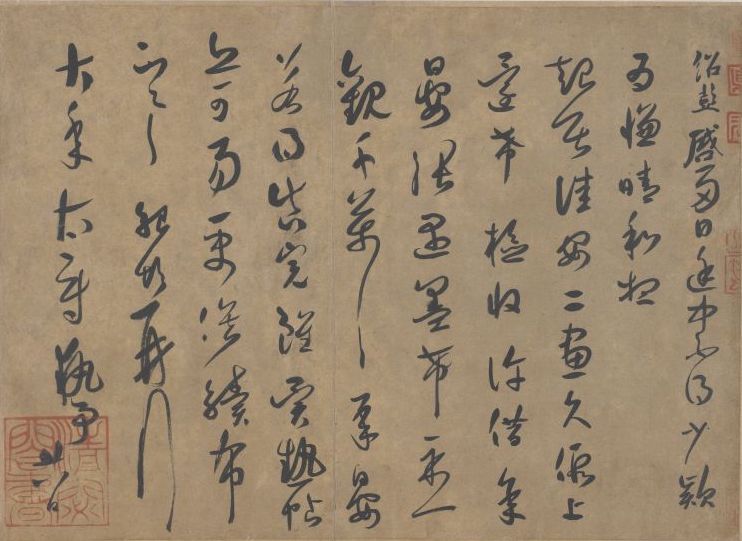
Song Xue Shaopeng cursive calligraphy New Year's page in the collection of the Palace Museum
Li Tingmo, who was quite precious in the Southern Tang Dynasty, was almost lost in the Song Dynasty, and Zhang Yumo was the best at this time. Cai Xiang once wrote: "The world takes Li Ting in Shezhou as the first, and Zhang Yu in Yishui as the second." Zhang Yu and Sun Chuhou are both famous ink-making experts, and they replaced the pine smoke with coal and changed the ink-making technology. In the ninth year of Xining of Song Shenzong (AD 1076 ), Su Song, the Duke of Wei, studied the history of the country . This is too few, and it should be treasured.” It can be seen that Zhang Yumo, which was stored in the inner court, is also precious. Song Xue Shaopeng's "New Year's Post" in the Palace Museum is a short note written to the imperial clan of the Northern Song Dynasty and the painter Zhao Lingrang. Both Xue and Zhao were famous collectors at that time. If the famous ink is made, if the genuine one is willing to exchange it with Xue's self-collected Wang Xizhi's "Heterothermal Post", it also shows how precious Zhang Mo was at that time.
Northern Song Dynasty Mi Fu's Running Script Coral Post Page Collection of the Palace Museum
The pen holder, also known as the pen grid and the pen holder, was originally a tool for placing the ink-dipped brush in order to prevent the pen tip from being scattered during use. In the late Tang Dynasty, Luo Yin's "Song of History" had the expression "Xu Ling's pen and inkstone coral frame". By the Song Dynasty, it was more common to use coral as a pen holder. The letter pen writes a coral branch, and the qiuqu is natural and natural. "Three branches of red grass come out of the golden sand, and it comes from the family of Tianzhijiexiang." Ming Dujin's "Fusheng Teaching the Scriptures" depicts the twenty-eight stories of Professor Fusheng Chao Cuo's "Shangshu". Bishan is also used as a research mountain, which can be used alone in addition to being combined with a coral pen holder. In Song Dynasty, Lu Yinglong's "Xianchuang Kuoyizhi" called it "the distant peaks are like a pen holder". Mi Fu once treasured Jinzhai Research Mountain and Cangxuetang researches the mountain. In the Yuan and Ming Dynasties, Yanshan has become not only a practical pen holder, but also one of the miniature landscape furnishings in the study. Gao Lian's "Yan Xianqing Appreciation Notes" records: "I saw a Song Dynasty person Lingbi researching the mountain, and the fragment of the peak is like Huang Zijiu's method. There is a pool of money, half an inch deep, and the bottom of the mountain is full of water. The waves are natural, and they are not artificial at first, so this is a real treasure." This kind of mountain-shaped pen holder, plate inkstone and small pot-shaped inkstone droplets are also seen in Wu Wei's "Wuling Spring Picture Scroll" in the Ming Dynasty.![(Ming) Du Jin's painting of Fu Sheng's teaching of scriptures (part), color on silk, 147 cm long, 104.5 cm wide [US] Collection of the Metropolitan Museum of Art](https://apollopic.nodefu.net/e7cdy9nhkhww8g3msyq5odb139a7jgyv.jpg)
(Ming) Du Jin, Fusheng Teaching Sutras (Part), ink and color on silk, vertical 147 cm, horizontal 104.5 cm [US] Collection of the Metropolitan Museum of Art
The literati in the Song Dynasty liked to live in Yanju, and there were often several summer pictures handed down. The Song Dynasty's "Huaiyin Summer Atlas" currently in the Palace Museum is one of the best. The Chinese painters are resting high under the landscape screen, sleeping peacefully and roaming the mountains and rivers. The table behind them is furnished with a multi-legged inkstone, a bundle of scriptures, a bamboo brush, and a treasure-shaped pen holder. This type of pen holder is very practical. The wooden pen holder was unearthed from the Tang Tomb No. 206 in Astana, Turpan, except for the brackets on both sides. In the painting, there is another four-legged fish-shaped gold-copper inkstone drop on the left side of the table. This inkstone is in the shape of a fish, with four-legged feet underneath, like a special-shaped four-legged tripod. A device that flows in air to control the speed of water at the mouth of the fish. In ancient times, inkstone droplets focused on accurate water discharge, which was the only way to ensure a strong ink color. The inkstone droplets seen in the previous Tang Wangwei's "Fusheng Teaching the Scriptures" and "Wuling Chuntu" volumes are more common small pot shapes.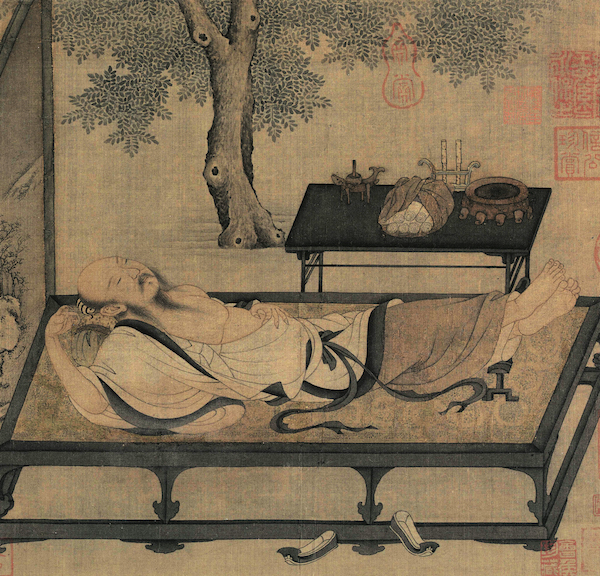
(Song) Anonymous Huai Yin Summer Map (Part) Ink and color on silk, 25 cm long and 26 cm wide, in the collection of the Palace Museum
Brush washing also flourished in the Song Dynasty. In Huang Tingjian's "Zhi Gong Yan Tong Zhi Zhi Shi's Slip", he said , "I went to beg for a small bowl, and I washed the brush next to the study ." Pen washes are often found in famous kiln porcelains in the Song Dynasty, especially Ru kilns have the most comprehensive records. In order to record his collection of antiquities, Emperor Qianlong ordered the painters of the Ruyi Museum of the Qing Palace to draw bronze and porcelain atlases twice in the fifty-second year of Qianlong (AD 1787) and the fifty-seventh year of Qianlong (1792 AD), among which the "Burning Art". "Changsei Atlas" and "Xiangliuguang Atlas" are porcelain drawings. There are two Ru kilns recorded in the "Burning Works and Colors", one of which is a boat-shaped pen washer from the Song Ru kiln. And the ones included in the "Liuang Liuguang Atlas" are Song Ru kiln qingkou washes and Song Ru kiln boat-shaped brush washes. Comparing with the handed down cultural relics, it can be seen that the inner bottom of the boat-shaped pen washer of Song Ru kiln painted in the "Burning Gong Showing Color " has "two ruyi dark flowers, a slight depression at the bottom, and three nails" , which should be currently in the collection of the David Foundation of the United Kingdom. Northern Song Dynasty Ru Kiln Celadon Oval Wash.The clear offering of the study room was originally a literati writing tool, and in the thousands of years of circulation, it gradually formed the study furnishings that represented the literati's aesthetic interest. These images and expressions of "Shangyi" are rarely recorded in the torrent of history, but the "recording" function of painting allows us today to have a glimpse of the elegant style of the ancient study. The study book serves writing and painting, but it has become a symbol of the history of famous objects recorded in painting and calligraphy after being circulated for thousands of years.
(The author of this article is an assistant researcher at the Institute of Archaeology, Chinese Academy of Social Sciences. The full text was originally published in the 33rd issue of "The Gate of the Great Craftsman" by the Beijing Academy of Painting, and edited by The Paper when it was transferred.)